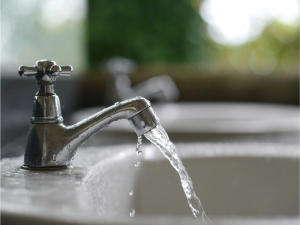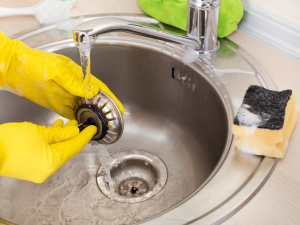Grease traps are an essential component of any commercial kitchen or food service operation. They prevent grease and oil from entering the sewer system and causing blockages, backups, and overflows.
In this blog post by our team at Clover Contracting, we’ll explore what a grease trap is, how it works, what it looks like, how it’s used and the importance of finding a trusted plumber.
What Is a Grease Trap? — An Expert Overview
A grease trap, also known as a grease interceptor or a grease recovery device, is a plumbing fixture that collects and separates fats, oils, and grease (FOG) from wastewater.
It’s typically installed between the kitchen sink or dishwasher and the sewer line. The utility value of grease traps is that they capture and retain the FOG, prior to it entering sewer systems and wreaking havoc.
Now that you know the answer to the question, “what is a grease trap?”, it’s time to learn how they work.
Fun Fact From Our Experts
The first patent for a grease trap was filed in 1887 by Nathaniel Whiting, a plumber from Massachusetts. His invention was designed to prevent fats, oils, and grease from clogging sewer lines and causing health hazards. Today, grease traps are still an important part of modern plumbing systems and are used in a variety of commercial and industrial settings.
How Does a Grease Trap Work in a Kitchen?
A grease trap works by using gravity and buoyancy to separate the FOG from the wastewater. When wastewater enters the grease trap, it slows down, allowing the fats, oils, and grease to rise to the surface. The FOG is then trapped in the grease trap, while the wastewater continues to flow through the outlet pipe and into the sewer line.
Most grease traps have two compartments, with the first one serving as a sedimentation chamber and the second one as a grease collection chamber. The sedimentation chamber allows solid particles to settle to the bottom, while the grease collection chamber collects the fats, oils, and grease.
The grease trap may also have a system that directs the flow of wastewater and prevents the FOG from escaping through the outlet pipe.
What Does a Grease Trap Look Like After It’s Installed?
A grease trap can come in different shapes and sizes, depending on the volume of wastewater and the number of fats, oils, and grease generated by the kitchen or food service operation. It can be located either above ground or below ground, and it can be made of various materials, such as plastic, fibreglass, stainless steel, or concrete.
Some grease traps have a lid or a cover that can be removed for cleaning and maintenance. Others have an automatic grease removal system that pumps out the collected FOG regularly.
Grease Trap Use Explained By Our Experts
To ensure that a grease trap functions properly, it’s essential to follow certain guidelines and best practices. These include:
- Scrape food scraps and solids into the trash before washing dishes or equipment: This will help to minimize the number of solids that enter the grease trap. Larger food particles and solids can clog the trap and reduce its effectiveness. By scraping them into the trash, you can prevent them from entering the wastewater stream and clogging your grease trap.
- Use strainers or filters on sinks and drains to capture solids: Installing strainers or filters on your sinks and drains can help to catch any remaining food particles or solids that may have been missed during the scraping process. This will prevent these particles from entering the grease trap and clogging it.
- Avoid pouring oil or grease down the drain or sink: It’s important to properly dispose of oil and grease by collecting them in a separate container and disposing of them in the trash or recycling. Pouring FOG down the drain or sink can cause them to solidify in the grease trap, clogging it and rendering it ineffective.
- Clean the grease trap regularly: Regular cleaning is essential to ensure that the grease trap continues to function effectively. Depending on the size and usage of your grease trap, it may need to be cleaned anywhere from once a month to once a year.
It’s important to educate employees and staff on the value of using the grease trap properly and following these best practices. Failure to use a grease trap correctly can lead to regulatory fines, unsanitary conditions, and costly repairs. By properly using and maintaining your grease trap, you can help to ensure a safe and healthy environment for your employees and customers.
Grease Trap Plumbing Explained
Installing a grease trap requires proper plumbing and drainage design. The size and location of the grease trap should be determined based on the volume of wastewater and the type of FOG generated by the kitchen or food service operation.
- The grease trap should be located as close as possible to the source of the FOG. Examples include the sink or dishwasher. It should also be easily accessible for cleaning and maintenance. The inlet and outlet pipes should be properly sized and connected to the grease trap.
- Any plumbing system should be vented. This prevents negative pressure and sewer gas odors from escaping into the building. The grease trap should also be equipped with a trap primer, which is a device that injects water into the trap to maintain the water seal and prevent sewer gas from entering the building.
- It’s important to comply with local plumbing codes and regulations when installing a grease trap. In some areas, a permit may be required, and the installation may need to be inspected by a plumbing inspector. It’s also important to choose a reputable and experienced plumber or contractor to do the installation, as improper installation can cause leaks, backups, and other problems.
What is a Grease Trap and How Does It Work? — Final Notes
A grease trap is an essential component of any commercial kitchen or food service operation that generates FOG. It’s designed to prevent FOG from entering the sewer system and causing problems.
Understanding how a grease trap works, what it looks like, and how it’s used and installed can help you maintain a safe and efficient kitchen or food service operation.
Remember to follow best practices for using and maintaining your grease trap, and to comply with local plumbing codes and regulations. By doing so, you can avoid costly fines, backups, and other problems, and ensure a safe and hygienic environment for your employees and customers.
Whether it’s for insurance or your own peace of mind, getting professional help is the best way to keep the pipes moving.




